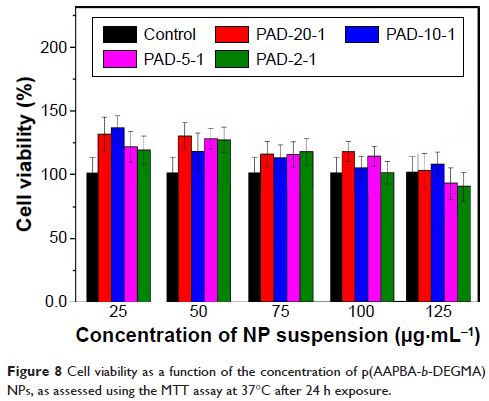论文已发表
提 交 论 文
注册即可获取Ebpay生命的最新动态
注 册
IF 收录期刊

Authors Wu JZ, Williams GR, Li HY, Wang D, Wu H, Li SD, Zhu LM
Received 22 January 2017
Accepted for publication 1 May 2017
Published 29 May 2017 Volume 2017:12 Pages 4037—4057
DOI http://doi.org/10.2147/IJN.S132984
Checked for plagiarism Yes
Review by Single-blind
Peer reviewers approved by Dr Akshita Wason
Peer reviewer comments 2
Editor who approved publication: Dr Lei Yang
Abstract: Glucose- and temperature-sensitive polymers of a phenylboronic acid
derivative and diethylene glycol dimethacrylate (poly(3-acrylamidophenyl
boronic acid-b -diethylene glycol methyl ether
methacrylate); p(AAPBA-b -DEGMA)) were
prepared by reversible addition–fragmentation chain transfer polymerization.
Successful polymerization was evidenced by 1H nuclear magnetic resonance and infrared
spectroscopy, and the polymers were further explored in terms of their glass
transition temperatures and by gel permeation chromatography (GPC). The
materials were found to be temperature sensitive, with lower critical solution
temperatures in the region of 12°C–47°C depending on the monomer ratio used for
reaction. The polymers could be self-assembled into nanoparticles (NPs), and
the zeta potential and size of these particles were determined as a function of
temperature and glucose concentration. Subsequently, the optimum NP formulation
was loaded with insulin, and the drug release was studied. We found that
insulin was easily encapsulated into the p(AAPBA-b -DEGMA)
NPs, with a loading capacity of ~15% and encapsulation efficiency of ~70%.
Insulin release could be regulated by changes in temperature and glucose
concentration. Furthermore, the NPs were non-toxic both in vitro and in vivo.
Finally, the efficacy of the formulations at managing blood glucose levels in a
murine hyperglycemic diabetes model was studied. The insulin-loaded NPs could
reduce blood glucose levels over an extended period of 48 h. Since they
are both temperature and glucose sensitive and offer a sustained-release
profile, these systems may comprise potent new formulations for insulin
delivery.
Keywords: diethylene
glycol methyl ether methacrylate, 3-acrylamidophenylboronic acid, nanoparticle,
thermosensitive, glucose sensitive, insulin delivery
